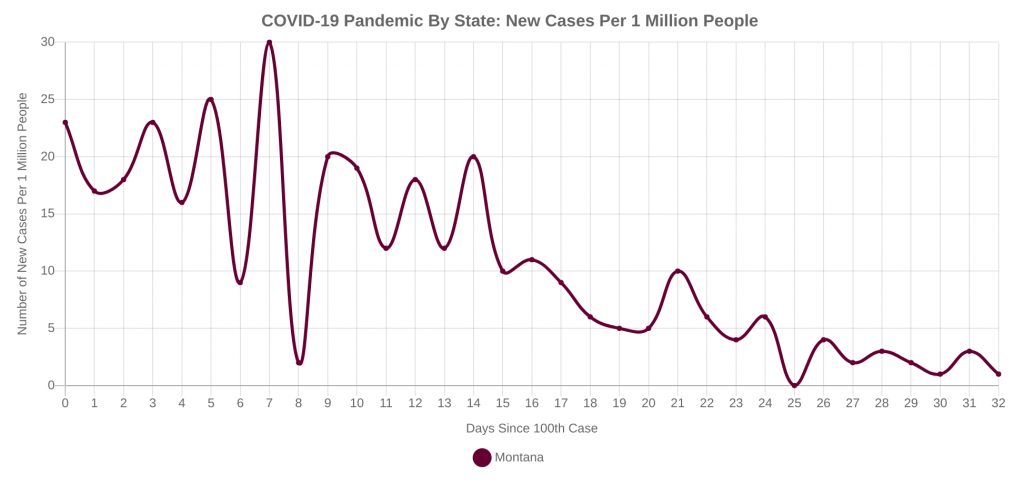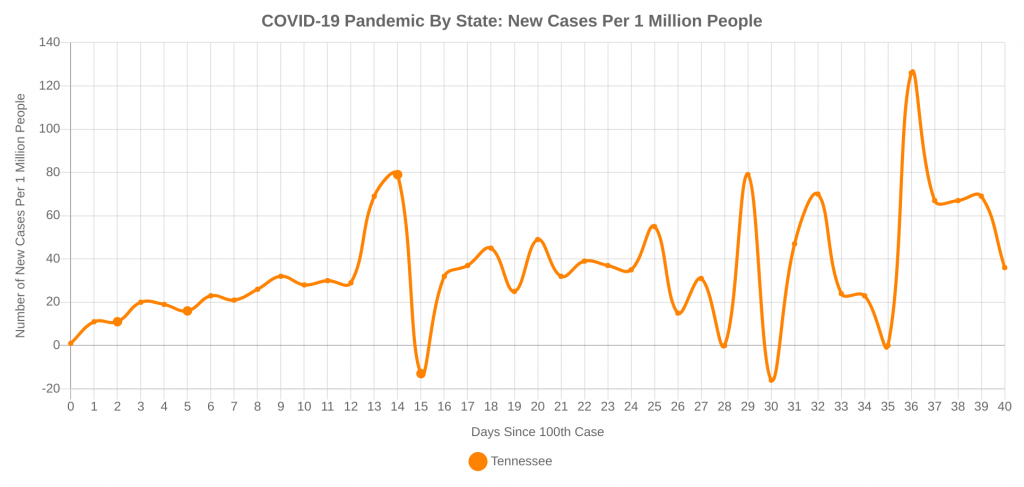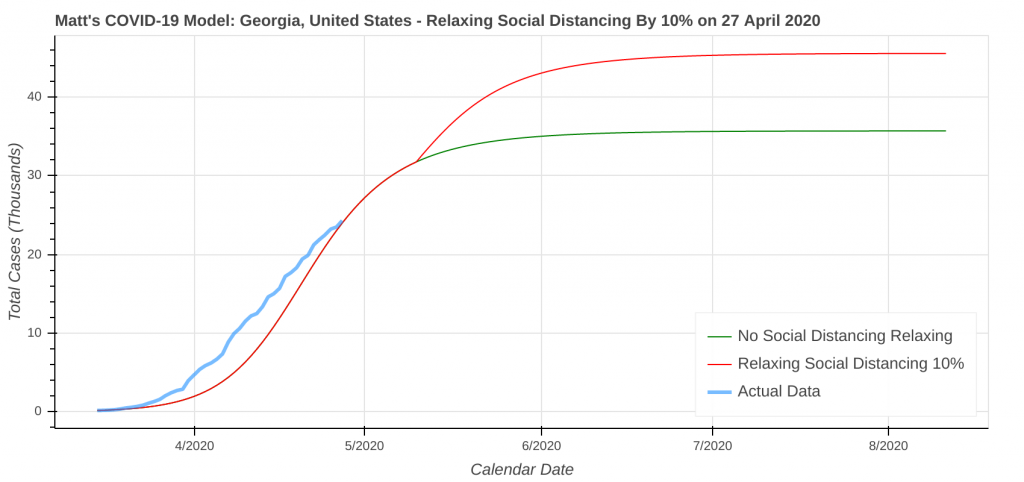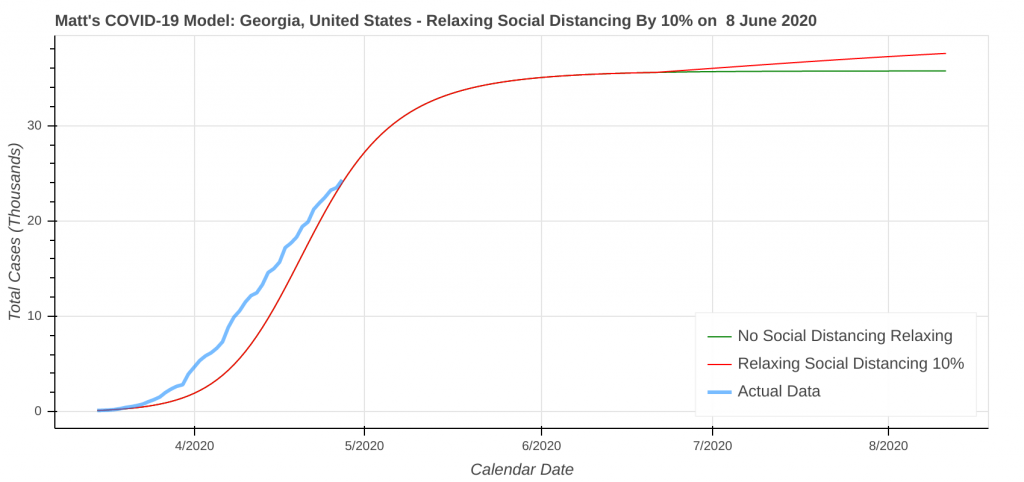You’ve probably seen the extensive news coverage of some US states that are reopening. Georgia, which started reopening last week, has made the most headlines over the past week or so. A lot of people are asking what will happen if, say, Georgia were to open before the models say they’ve met the necessary criteria. Let’s have a look. We will be looking at this strictly from a mathematical and public health perspective.
The US Federal Government laid out clear gating criteria each state should meet before moving to the next phase of their three-phase process reopening. My datasets and models do not track all of those gating criteria, so we will be looking at a couple of the most important guidelines:
- Documented downward trajectory of confirmed new cases over the past 14 days
- 3-Day Average of less than 5 to 7 new cases per million people
- The largest daily increase in new cases over the past 14 days must be no more than 5 to 7 new cases per million people
Look at the Actual Data to Gauge State Reopening Viability
So what exactly does a 14-day downward trajectory of confirmed new cases look like? Have a look at Montana, which is one of only about two or three states that’s even remotely close to meeting the White House’s gating criteria at the present time.

Now, what does the same plot look like for Georgia and other states that are starting to reopen businesses? Click on any image to enlarge it.
In the table below, all values are normalized per 1 million population.
| State | Avg Daily New Cases Apr 12-14 | Avg Daily New Cases Apr 25-27 | 14-Day General Trend | 14-Day Max Daily Increase |
| Florida | 48 | 24 | Down | 64 |
| Georgia | 75 | 56 | Down | 142 |
| Tennessee | 34 | 58 | Up | 126 |
| Texas | 22 | 19 | Down | 45 |
One thing should jump out at you immediately: While three of the four states meet one of the gating criteria (general trend downward in new cases), Texas is the only state that’s anywhere remotely close to being able to meet the gating criteria. Even though spikes in the daily new case counts are a bit concerning, both Florida and Texas showing promising signs of trending downwards and if they keep it up, will hopefully be able to meet the gating criteria by late May or early June.
What are the Models Saying About State Reopening?
The University of Washington’s IHME model recently added a projection of when states can begin relaxing social distancing guidelines. These projections are estimated based on the gating criteria. I added the same projections to my model. Here are the earliest dates the latest runs are predicting states can begin to reopen.
| State | IHME Model | My Model |
| Florida | June 21 | May 26 – June 8 |
| Georgia | June 28 | June 8 – June 24 |
| Tennessee | May 24 | June 16 – July 6 |
| Texas | June 15 | May 29 – June 13 |
So why are these dates so important? It’s quite simple actually. Using Georgia as an example, look at the projected cumulative case counts for what happens when you slightly relax social distancing restrictions before meeting the gating criteria (Georgia re-opened on April 27) vs waiting for the earliest suggested date (June 8) that the models indicate.
Interestingly, many models are already adjusting their case, hospitalization, and death counts up to account for states beginning to reopen.
The Verdict
So are states like Georgia, Texas, and others opening too early. Unfortunately, from just the small amount of data presented in this post, you can’t say for sure. I know, I know, it’s a cop-out, but there are so many additional factors that are not taken into account in this analysis, such as;
- Can the health care systems in these states handle the uptick in cases as things reopen?
- Even if businesses reopen, will people patronize them or are people still too concerned to go out?
- What about the economic destruction the virus is causing?
Here’s my two cents. Governors are going to have to tread a fine line between balancing health care concerns against the economy. Strongly favoring one will cause great harm from the other. While just relaxing social distancing restrictions even the tiniest little bit will likely lead to at least a slight increase in case counts, the goal is to strategically and gradually reopen the economy in steps so that you can keep the virus under control at the same time.
If governors who are reopening their states now can begin and maintain an economic recovery while at the same time keeping COVID-19 case and death counts down, they have not opened too early. If they have to shut down their economies down again and re-issue social distancing restrictions due to a big spike in cases, well, that’s a different story.
Top Picture: Talimena Scenic Drive – Talihina, Oklahoma – November, 2013





